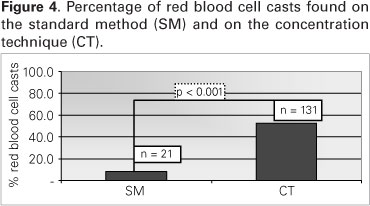INTRODUCTION: Dysmorphic red blood cells (RBCs) in the urine are a strong indicator of a glomerular bleeding source. RBC casts, which while generally following RBC dysmorphism are not frequently seen on routine urinalysis, are also important indicators of glomerular hematuria. OBJECTIVE: This study tested the superiority of a urine concentration technique (CT) over the standard method (SM) for RBC cast identification in a group of patients suspected of glomerular hematuria. MATERIAL AND METHODS: Of a total of 4,227 routine urinary samples, 249 with dysmorphic hematuria were selected. The samples were processed according to two techniques: standard method (SM) and concentration technique (CT). The percentages of RBC cast identification according to each method were compared. RESULTS: The CT showed a higher rate of RBC casts (52.6%) compared to the SM (8.4%) (p < 0.001). DISCUSSION AND CONCLUSION: We suggest that the SM did not sufficiently concentrate the urine sample, the RBC casts remaining in the supernatant and being discarded. The CT increased the sensitivity of the RBC cast yield. The CT, associated with the presence of RBC dysmorphism, was useful to increase the agreement of the two parameters used for identification of glomerular-based bleeding and the diagnosis of glomerular diseases, important causes of chronic kidney disease.
Urinary sediment; Dysmorphic red blood cells; Red blood cell casts; Glomerular hematuria; Glomerulonephritis






